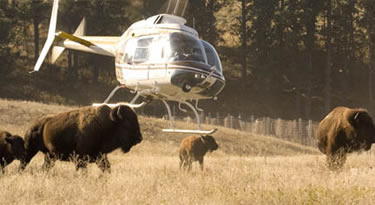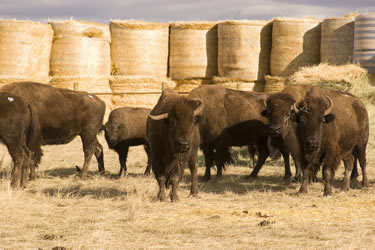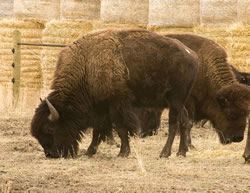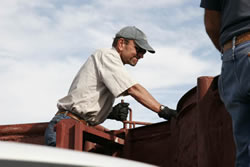Home on the Range
Air Date: Week of November 18, 2005
Sixteen genetically pure American Bison were released on a new wildlife preserve in northeastern Montana. The World Wildlife Fund and the American Prairie Foundation teamed up to purchase and prepare 32,000 acres of land for the buffalo. Host Steve Curwood talks with WWF program director, Curt Freese (Fray-zee), about what the reintroduction of bison will mean for the ecosystem.
Transcript
CURWOOD: It's Living on Earth. I'm Steve Curwood.
The American West was once teeming with wildlife, including the great herds of buffalo. But these days, you're more likely to see cows. So the World Wildlife Fund, in partnership with the American Prairie Foundation, is working to get the prairies of northeast Montana back to the wild west they once were.

Bison Roundup (Photo: Diane Hargreaves)
Curt Freese directs the project and he joins us from Bozeman, Montana. Hello, sir!
FREESE: Hi, good to be here.
CURWOOD: To begin with, what is a genetically pure bison? And why is this a specification that needs to be made?
FREESE: It's important because there may be about 500,000 bison in North America, but about 96 percent of those are being bred for small humps and fat rumps and ease of handling. And the wild bison, the bison that are in conservation herds, may be only about 20,000. And of those, most of those have cattle genes mixed in so there's some genetic pollution that we don't know what the consequences may be, so, for conservationists, we feel as long as we can get a pure bison genome, we ought to save it.

(Photo: Diane Hargreaves)
CURWOOD: Okay, I need an ecology lesson here. I look out at the Great Plains and, you know, it looks like some grass. But the to trained eye it's quite a sophisticated ecosystem. Why are bison so important to this particular ecosystem, the Great Plains?
FREESE: Well, bison were, they were probably one of the two, what we call, keystone species out there. The other one was the prairie dog. We estimate when Europeans settled in this continent there were maybe 30 to 60 million bison. And, consequently, the bison is important for scavengers and predators as a big protein bundle. But also, as a major grazer out there, it created this mosaic of grazing intensities that moved over the landscape in large herds and, consequently, the wildlife of the Great Plains adapted to these bison grazing. An indication of maybe what's gone wrong with the loss of the bison is that grassland birds are undergoing steeper declines in their populations than any other group of birds in North America.
CURWOOD: So, if I were standing there in the Great Plains in this pretty much original grasslands part of the Great Plains, it sounds like, where you're going to have these bison out on the plains, what would I see? What would it look like? What would it sound like?
FREESE: Well, if you're out there in the spring, it's a cacophony of birdcalls. It wakes you up about 4:30 in the morning. You hear mating calls, courtship calls. And if the bison are nearby you'll hear them grunting to each other. They have this wonderful grunt sound that they communicate with. The bison calves are constantly grunting, looking for their mom, keeping up with their mom.

(Photo: Diane Hargreaves)
FREESE: It goes more or less like Unh, Unh. Unh.. That's not very good, though, my bison friends are going to laugh at me.
CURWOOD: [LAUGHS] Unh, unh, unh, unh.
FREESE: [LAUGHS] Right. You're better than I am, that's good!
CURWOOD: [LAUGHS]
FREESE: So, it's really a rich sound. And the view of the bison grazing, prairie dogs - of course, prairie dogs barking is another aspect of the prey ecosystem out there. Prairie dogs are important food items for a lot of the raptors, golden eagles and hawks. And so there's this real mosaic, like you said.
If you just drive through quickly you don't notice it. But if you stop and look you say, "wow, there's an incredible abundance and diversity of life." The area we're working in, we just had some plant work done. We think there's about 600 species of plants out there. There's more than 200 species of birds. And so it's quite a remarkable place.
CURWOOD: What do you think a park like this is going to bring to the local community?
FREESE: It's got tremendous potential for drawing in tourists from outside. And the economy of the communities can no longer stand on the single leg of agriculture, and so we think this is a unique opportunity we have in this to bring back what was once there in the Great Plains. The spectacular wildlife, and kind of have this diversity of land uses of prairie reserves, but also ranching where it makes sense, too. We haven't lost anything. The bison are still around, we just need to put them back out there and they'll thrive. All they need is some space and time.
CURWOOD: This is going to be the home where the buffalo roam?

Curt Freese at Wind Cave. (Photo: Diane Hargreaves)
CURWOOD: Curt Freese is the director of the Northern Great Plains Program for the World Wildlife Fund. Thanks for taking this time.
FREESE: Thank you, Steve, it's been a pleasure.
Links
Living on Earth wants to hear from you!
Living on Earth
62 Calef Highway, Suite 212
Lee, NH 03861
Telephone: 617-287-4121
E-mail: comments@loe.org
Newsletter [Click here]
Donate to Living on Earth!
Living on Earth is an independent media program and relies entirely on contributions from listeners and institutions supporting public service. Please donate now to preserve an independent environmental voice.
NewsletterLiving on Earth offers a weekly delivery of the show's rundown to your mailbox. Sign up for our newsletter today!
 Sailors For The Sea: Be the change you want to sea.
Sailors For The Sea: Be the change you want to sea.
 The Grantham Foundation for the Protection of the Environment: Committed to protecting and improving the health of the global environment.
The Grantham Foundation for the Protection of the Environment: Committed to protecting and improving the health of the global environment.
 Contribute to Living on Earth and receive, as our gift to you, an archival print of one of Mark Seth Lender's extraordinary wildlife photographs. Follow the link to see Mark's current collection of photographs.
Contribute to Living on Earth and receive, as our gift to you, an archival print of one of Mark Seth Lender's extraordinary wildlife photographs. Follow the link to see Mark's current collection of photographs.
 Buy a signed copy of Mark Seth Lender's book Smeagull the Seagull & support Living on Earth
Buy a signed copy of Mark Seth Lender's book Smeagull the Seagull & support Living on Earth

